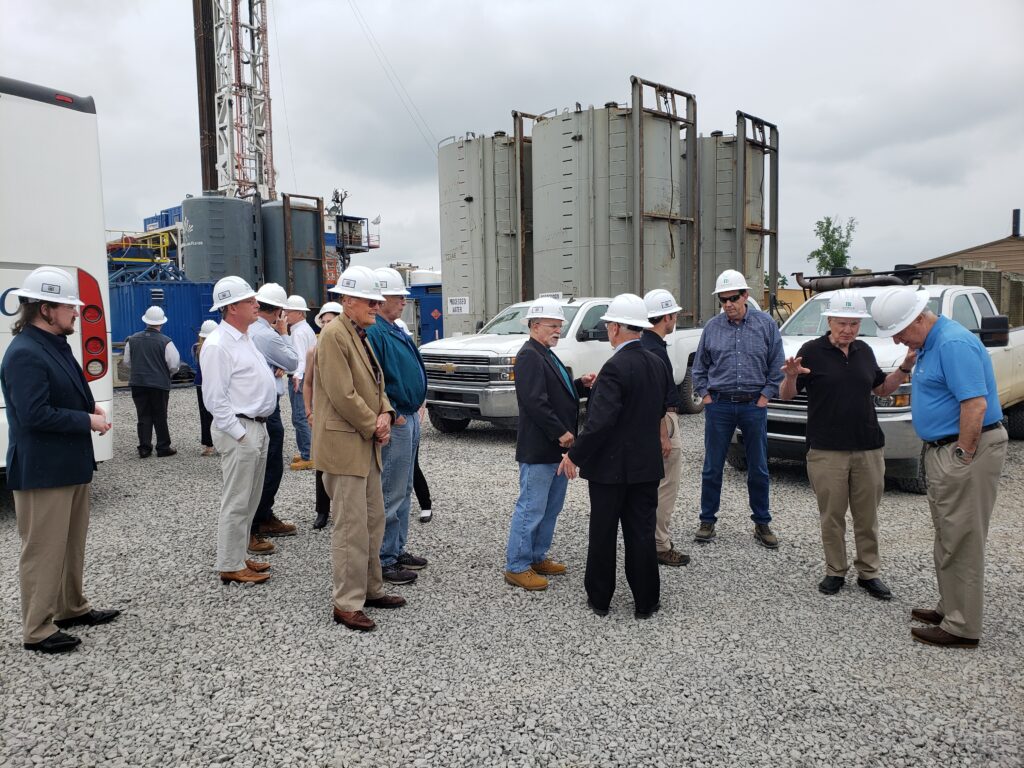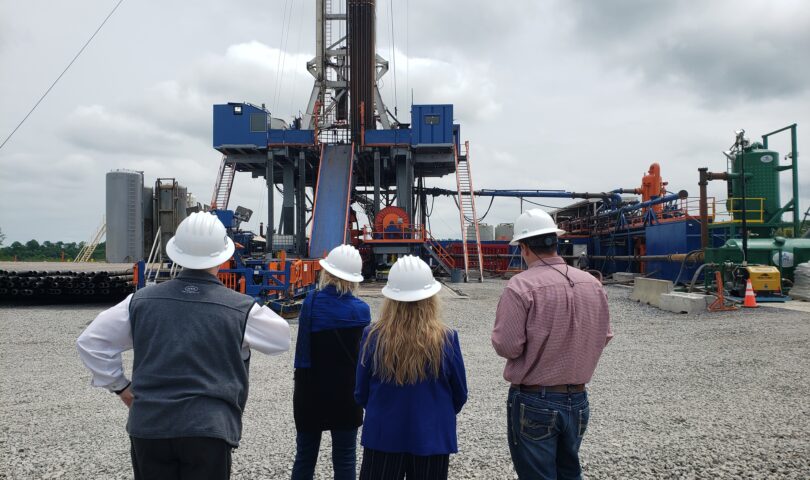MORGANTOWN – Severance tax collections from natural gas outpaced coal for the first three quarters of Fiscal Year 2022, and a group of state legislators had the opportunity to visit a well pad on Tuesday and see a drilling operation first hand.
Legislators were in town for May interim meetings and GO-WV – the Gas and Oil Association of West Virginia – arranged with Morgantown- and Charleston-based Northeast Natural Energy to visit its Yost pad in Western Monongalia, between Daybrook and Fairview.

NNE President Mike John told the legislators, “I appreciate your taking the time to come and look at what we do.”
Northeast has six active wells on the pad, drilled in 2014 and 2018. This is their third and final drill there, and the members watch the rig send 90-foot sections of casing down into the ground for the second of five planned wells.
The wells will go down 8,299 feet and horizontally 19,000. When drill is done, the rig will be sent on and fracking will begin in three to four months. Gas from the existing wells powers the rig and three generators that in turn power the pumps and all the huts on site.
John told the members NNE operates 126 active wells – 120 in Monongalia County – producing 500 million cubic feet per day. He previously worked for a company that produced one-fifth of that volume with 7,000 vertical wells.

“We’re able to produce a tremendous amount of energy here in West Virginia,” he said.
John gave members a handout that showed them in 2021, NNE paid $50.3 million in royalties and $17.2 million in severance and property taxes.
He and other NNE staffers talked about NNE’s environmental concerns. In 2021, it recycled 108% of its wastewater (the extra 8% comes from water sharing agreements with other producers).
John told them about two achievements previously reported in The Dominion Post: Equitable Origin’s EO100 Standard for Responsible Energy Development and the MiQ methane standard for methane intensity, company practices and methane detection technology deployment.
“We want people to see what we’re doing,” he said. “We want people to understand what we’re doing.”
After the tour, The Dominion Post spoke to four legislators who set foot on a well pad for the first time on Tuesday.

Delegate Joey Garcia, D-Marion, said Mon and Marion aren’t as prominent as Doddridge and Marshall for their gas operations, but, “this is a really important part of the economy here.”
Legislators make decisions that affect the industry, he said. “For me to visually be ale to see it makes it a little more understandable.”
Sen. Patricia Rucker, R-Jefferson, represents an area with no gas operations or industry. “I learned a lot. I was very impressed with the operations,” she said. “I was very grateful for the opportunity to see what it really is. We hear about it all the time in committee meetings and now I can visualize it.”
Delegates Margitta Mazzocchi, R-Logan, and Laura Kimble, R-Harrison, toured the site with NNE Drilling Manager Josh Dalton, and had a steady stream of questions.
Kimble was impressed with many of the technical aspects of the operation – the depth and length of the well bores, the ability of the rig to lift itself 8 inches off the ground and roll the 20 feet to the next bore site – the fie wells will be drilled 20 feet apart at the surface but will be 1,000 feet apart for their horizontal legs.
Mazzocchi said, “Everything was new.”
She was impressed with the rig crew’s work ethic. “It’s interesting to see how hard the people are working here to give us the energy that we need.” They have two weeks on with 12-hour shifts, then two weeks off. “To be completely engulfed in the life here … it takes special men to do this.”
Tweet David Beard @dbeardtdp Email dbeard@dominionpost.com




